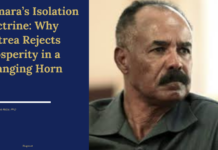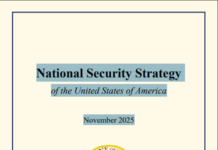Horn Review
Eritrea’s contemporary governance cannot be separated from the shape of its institutions and the political choices that defined the post-liberation trajectory. Institutions are the durable routines and organizations through which authority is exercised, resources are allocated and conflicts are managed. When those routines are weak or subordinated to a narrow political formation, the state may retain capacities in enforcement and resource extraction while losing the predictable, rule-bound mechanisms that sustain development, rights and resilient diplomacy.
The historical sediment of institutions in Eritrea is layered and consequential. Italian colonial rule left a built environment and administrative imprint in Asmara and port cities, including roads, civic architecture and initial modern schools and health structures. These material legacies shaped early elites and created an urban administrative core that subsequent rulers adapted. After World War II and during the period of federation and annexation with Ethiopia, many public functions were managed from Addis Ababa or through hybrid arrangements that mixed local administrators with imperial structures. Independence produced a political opening for the creation of a sovereign bureaucracy, yet the inheritance of colonial-era infrastructure and the wartime administrative culture of the liberation movement meant that state building began from an uneven institutional base. The pattern of repurposing older institutions rather than building autonomous, plural organizations set an early tenor for how institutions would be used as they became instruments of state control and identity formation as much as service delivery. Those foundational weaknesses have largely persisted over the past three decades.
The transition from liberation movement to ruling party left a critical imprint on institutional development. The PFDJ emerged from the armed struggle with a centralized command. Those organizational habits may have served wartime logistics and in the immediate tasks of post-war order, but they were insufficiently recalibrated for the needs of plural governance. A formal constitution, produced in 1997, established a legal blueprint for representative institutions and civil rights, yet the operationalization of that document never occurred. The gap between constitutional text and daily political practice created a fundamental fault line. Laws and proclamations accumulated, but the autonomous institutions designed to interpret, enforce and balance those laws were not given the space or the capacity to function independently. That divergence became a defining feature of the subsequent political settlement.
There are interlocking institutional deficits explain much of Eritrea’s policy and social outcomes. Representative politics and electoral accountability were effectively suspended, removing ordinary mechanisms for holding the executive accountable and mediating elite competition. Judicial independence and due process were never fully insulated from security imperatives, so legal institutions operate under pervasive limitations. The civil service and public administration came to function as instruments through which personalized appointments and informal networks directed policy and resources, rather than as professional, merit-based bodies capable of iterative, evidence-driven policy making. The economy was restructured so that party-linked enterprises and state firms dominated key sectors, with Hidri Trust positioned at the center of this system. These dynamics were mutually reinforcing and over time produced feedback loops that made institutional reform more difficult.
Concrete examples illuminate the institutional logic at work. The Sawa training complex shows how inherited institutions were reshaped after independence. The facility originated as an Ethiopian military base, and its transformation into a national training center highlights Ethiopia’s enduring imprint on the Eritrea’s institutional and military foundations. Over time it became the central site for conscription and basic military training, turning it into a key instrument of state control. Its function became inseparable from the state’s security logic and from the management of youth labor. The Sawa example thus links institutional design directly to long-term human-capital outcomes and to the erosion of alternative civic pathways.
The University of Asmara offers another complementary case. Founded in the late 1950s through missionary and colonial initiatives, the university became the country’s principal tertiary institution and a reservoir of professional cadres. Its history reflects the broader institutional rhythm of the country, moving from a more plural academic life into tighter state control during and after the 1990s. Policies that reorganized higher education, closed parts of the university, and reallocated training into state-aligned institutes weakened the institutional autonomy necessary for research, technical training and independent professionalization. The loss of a robust, autonomous university weakened the country’s ability to produce civil servants, technical experts and independent professional voices that, in other settings, would sustain institutional accountability and informed policy debate. The erosion of higher education capacity is therefore not a peripheral effect, it is central to the reproduction of a state whose administrative competence is concentrated but whose social and economic institutions are brittle.
The media sector illustrates the broader pattern of institutional inheritance without autonomous development. The main structures of the Ministry of Information, including the television and radio facilities, were not newly constructed after independence but were the same broadcasting infrastructures that had operated under Ethiopia and folded into a centralized communication apparatus. Instead of evolving into a professional public institution, the ministry became an extension of the political command, with no independent editorial or administrative space. The economic sphere followed a similar trajectory. The Red Trading Sea Corporation grew into a dominant economic actor that controlled major commercial activities, procurement channels and hard-currency flows, allowing the ruling circle to manage the economy through a party-linked monopoly rather than through transparent state institutions. In this environment civil society never emerged as an organized sphere that could mediate interests or generate independent oversight, which further entrenched a system where information, economic power and public life were tightly held within a narrow elite structure.
Institutional fragility also shaped regional diplomacy and the durability of peace initiatives. The 2018 peace accord with Ethiopia illustrated both the foreign policy opportunities open to Asmara and the limits of executive-led agreements that are not embedded in routinized institutional mechanisms. Where durable peace requires demobilization plans, joint commissions, parliamentary oversight and legal instruments for cross-border cooperation, the absence of such routinized mechanisms meant the rapprochement rested heavily on leader-to-leader arrangements and personal trust. That form of agreement is inherently vulnerable to elite turnover or shifts in incentives. In short, a state that externalizes decision making to concentrated executives without corresponding institutional anchors risks rapid reversals and missed opportunities for stable regional integration.
The human consequences of these institutional choices are tangible and cumulative. Indefinite national service has been a major driver of emigration and of long-term labor market distortions. The concentration of economic opportunity within a narrow network reduces incentives for broad-based investment and job creation. Restrictions on civil society, independent media and academic freedom limit public scrutiny and blunt the formation of policy coalitions that might advocate for reform. In combination, these outcomes reduce societal resilience to shocks such as drought, price volatility and regional instability.
Any realistic reflection on institutional reform must confront the political settlement that sustains the current configuration. Institutions do not rise by decree when elites perceive their power to be threatened by independence of oversight. At the same time, the concentration of decision-making creates clear leverage points where targeted, technically credible reforms can deliver visible gains and begin to shift incentives. International engagement can support such shifts, but external pressure without locally credible sequencing risks entrenching nationalistic resistance and hardening elite opposition. The sequencing of reform and the provision of credible guarantees to manage elite loss-aversion are therefore central to any pathway that seeks durable institutional renewal.
The state structures that emerged after independence never escaped their original constraints and continue to operate with limited professional autonomy, heavy political oversight and a governing style rooted in the practices of the liberation era. The core challenge is political. Unless reformers can design a credible, phased approach that reduces perceived risks to the ruling formation while expanding public benefits, institutional renewal will remain incomplete and fragile.






